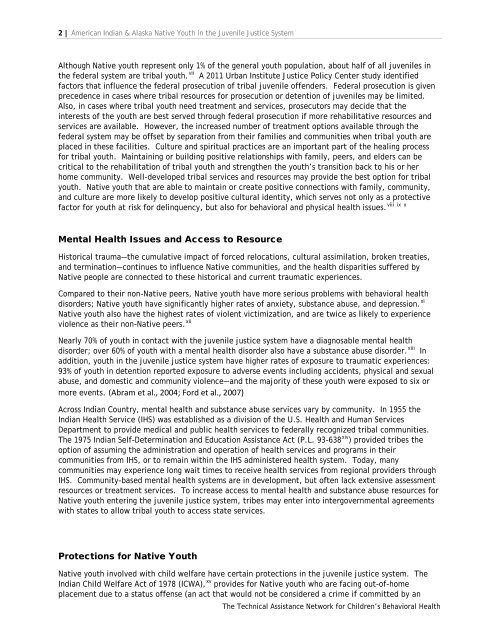Native American Youth In The Juvenile Justice System
Native American Youth In The Juvenile Justice System
Native American Youth In The Juvenile Justice System
Create successful ePaper yourself
Turn your PDF publications into a flip-book with our unique Google optimized e-Paper software.
2 | <strong>American</strong> <strong>In</strong>dian & Alaska <strong>Native</strong> <strong>Youth</strong> in the <strong>Juvenile</strong> <strong>Justice</strong> <strong>System</strong><br />
Although <strong>Native</strong> youth represent only 1% of the general youth population, about half of all juveniles in<br />
the federal system are tribal youth. vii A 2011 Urban <strong>In</strong>stitute <strong>Justice</strong> Policy Center study identified<br />
factors that influence the federal prosecution of tribal juvenile offenders. Federal prosecution is given<br />
precedence in cases where tribal resources for prosecution or detention of juveniles may be limited.<br />
Also, in cases where tribal youth need treatment and services, prosecutors may decide that the<br />
interests of the youth are best served through federal prosecution if more rehabilitative resources and<br />
services are available. However, the increased number of treatment options available through the<br />
federal system may be offset by separation from their families and communities when tribal youth are<br />
placed in these facilities. Culture and spiritual practices are an important part of the healing process<br />
for tribal youth. Maintaining or building positive relationships with family, peers, and elders can be<br />
critical to the rehabilitation of tribal youth and strengthen the youth’s transition back to his or her<br />
home community. Well-developed tribal services and resources may provide the best option for tribal<br />
youth. <strong>Native</strong> youth that are able to maintain or create positive connections with family, community,<br />
and culture are more likely to develop positive cultural identity, which serves not only as a protective<br />
viii ix x<br />
factor for youth at risk for delinquency, but also for behavioral and physical health issues.<br />
Mental Health Issues and Access to Resource<br />
Historical trauma—the cumulative impact of forced relocations, cultural assimilation, broken treaties,<br />
and termination—continues to influence <strong>Native</strong> communities, and the health disparities suffered by<br />
<strong>Native</strong> people are connected to these historical and current traumatic experiences.<br />
Compared to their non-<strong>Native</strong> peers, <strong>Native</strong> youth have more serious problems with behavioral health<br />
disorders; <strong>Native</strong> youth have significantly higher rates of anxiety, substance abuse, and depression. xi<br />
<strong>Native</strong> youth also have the highest rates of violent victimization, and are twice as likely to experience<br />
violence as their non-<strong>Native</strong> peers. xii<br />
Nearly 70% of youth in contact with the juvenile justice system have a diagnosable mental health<br />
disorder; over 60% of youth with a mental health disorder also have a substance abuse disorder. xiii <strong>In</strong><br />
addition, youth in the juvenile justice system have higher rates of exposure to traumatic experiences:<br />
93% of youth in detention reported exposure to adverse events including accidents, physical and sexual<br />
abuse, and domestic and community violence—and the majority of these youth were exposed to six or<br />
more events. (Abram et al., 2004; Ford et al., 2007)<br />
Across <strong>In</strong>dian Country, mental health and substance abuse services vary by community. <strong>In</strong> 1955 the<br />
<strong>In</strong>dian Health Service (IHS) was established as a division of the U.S. Health and Human Services<br />
Department to provide medical and public health services to federally recognized tribal communities.<br />
<strong>The</strong> 1975 <strong>In</strong>dian Self-Determination and Education Assistance Act (P.L. 93-638 xiv ) provided tribes the<br />
option of assuming the administration and operation of health services and programs in their<br />
communities from IHS, or to remain within the IHS administered health system. Today, many<br />
communities may experience long wait times to receive health services from regional providers through<br />
IHS. Community-based mental health systems are in development, but often lack extensive assessment<br />
resources or treatment services. To increase access to mental health and substance abuse resources for<br />
<strong>Native</strong> youth entering the juvenile justice system, tribes may enter into intergovernmental agreements<br />
with states to allow tribal youth to access state services.<br />
Protections for <strong>Native</strong> <strong>Youth</strong><br />
<strong>Native</strong> youth involved with child welfare have certain protections in the juvenile justice system. <strong>The</strong><br />
<strong>In</strong>dian Child Welfare Act of 1978 (ICWA), xv provides for <strong>Native</strong> youth who are facing out-of-home<br />
placement due to a status offense (an act that would not be considered a crime if committed by an<br />
<strong>The</strong> Technical Assistance Network for Children’s Behavioral Health

















